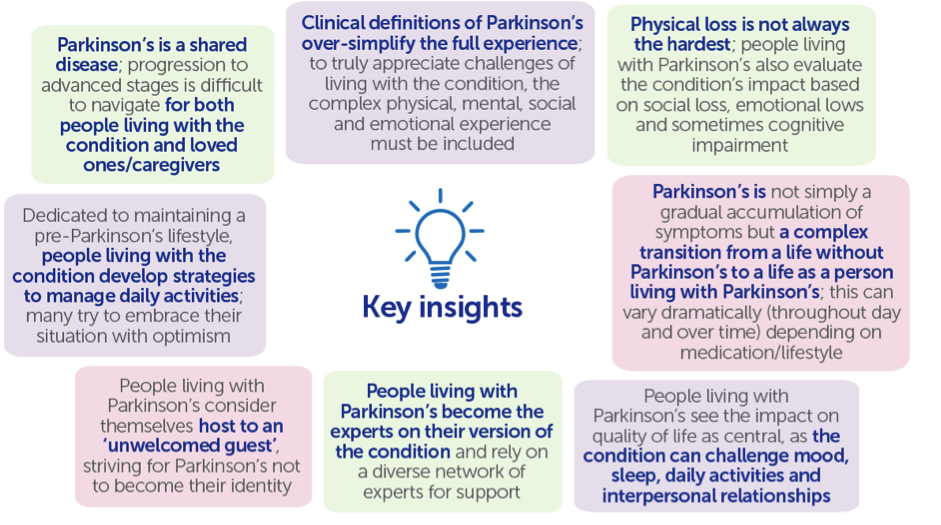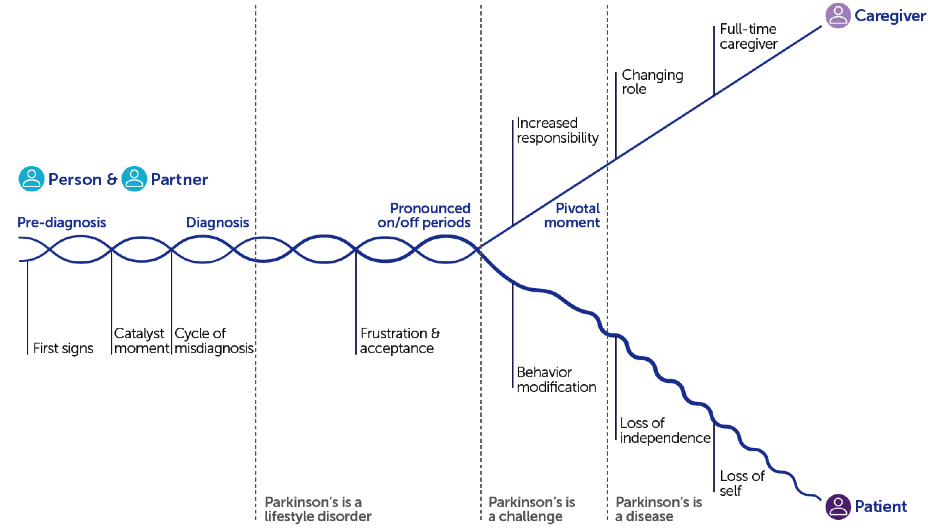
An innovative market research (“research”) programme, STEP™, aims to move beyond the focus on Parkinson’s symptoms to examine the real lived experience of Parkinson’s. We look at how the STEP™ programme sheds light on the impact of the condition on a person’s life, relationships and identity – and how it can help address the multiple dimensions of the condition
When people think of Parkinson’s, they are likely to think of the most widely recognised symptoms such as tremor and movement difficulties. But, as people living with the condition will emphasise, its impact goes much wider, affecting a person’s relationships and their sense of self.
A recent piece of research aimed to gain a fuller understanding of this impact. STEP™ was an innovative, ethnographic and context lab research programme undertaken in the UK, US and Canada. The programme included 63 people with Parkinson’s, between the ages of 40 and 76, who had lived with Parkinson’s for between six months and 21 years and had varied experiences of treatment. A total of 19 partners and those providing care, 18 healthcare professionals and other Parkinson’s experts also took part.
Researchers visited participants at home to glean first-hand experiences about living with the condition. People living with Parkinson’s and their loved ones were asked to speak freely about their experiences, and some also took part in group discussions where they shared the aspects that mattered most to them.
“People with Parkinson’s spoke freely about living with the condition”
The academics – who were anthropologists and strategists – also held in-depth one-to-one interviews with healthcare professionals and other experts who have frequent contact with people living with the condition, and visited the places where they interact.
The findings may not be that surprising to those familiar with Parkinson’s (see key insights from STEP™ research below), but researchers hope that this evidence-based research will help those who look after people with Parkinson’s to develop more appropriate and holistic approaches, with the confidence that they are addressing real needs. By giving a voice to people with Parkinson’s, STEP™ may well lead to solutions that improve how an individual views their experience of the condition.
Key insights from STEP™ research

In addition to key research insights, the findings suggest that people with Parkinson’s first experience the condition as a lifestyle disorder, then as intermittent periods of capability and loss, and finally as a loss of independence. Often forgotten in this are their loved ones who also experience a transition, with partners, friends and family members often becoming full-time caregivers as the condition progresses.
“By giving a voice to people with Parkinson’s, STEP™ may lead to better solutions”
Based on these insights, the following phases have been identified throughout the patient and loved-one or caregiver journey as Parkinson’s unfolds:
Pre-diagnosis – a person notices a ‘first sign’ such as a finger twitch. At first, these early symptoms are often rationalised as part of the natural ageing process.
Diagnosis – a moment of transition that alters a person’s understanding of their own physical health.
Lifestyle – a period of adjustment to a new way of life marked by mild to moderate limitations: Parkinson’s feels like a bother, not a disease.
Straddle – moving back and forth between pre-Parkinson’s life in “on” (medication is working and symptoms reduced) and glimpses of the disease in “off” moments (medication effect has worn off and symptoms become more severe).
Disease – after years of navigating “on” and “off” periods, the experience of Parkinson’s transforms into a ‘disease’ in the medical sense of the word. Unmanageable fluctuations, loss of independence, development of other conditions and medication side-effects begin to affect the patient’s entire personhood as they know it.

While every individual’s journey will be unique and complex, these common attributes allow those providing support to think about more than managing the physical symptoms. Incorporating the social, emotional and relationship aspects of living with Parkinson’s – and offering solutions as appropriate – can help both the person with Parkinson’s and their loved ones or caregivers to maximise positive outcomes along their journey. Ref: HQ/1217/NU/00088
Parkinson’s Europe is sharing this article for information purposes only; it does not represent Parkinson’s Europe’s views and is not an endorsement by Parkinson’s Europe of any particular treatments, therapies or products.